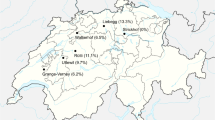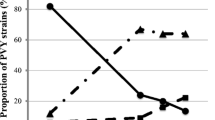Abstract
This study documented the presence of PVYo, PVYNTN, and PVYN-Wi strains in western Washington in 2012 and 2013, representing the first detections of PVYNTN and PVYN-Wi in this potato growing region. Chieftain and Yukon Gold plantings showed an unexplained shift to a higher proportion of PVYN-Wi in 2013 compared to 2012. In 2012, 56.4 % of positive plants pooled across cultivars were affected by PVYN-Wi while 39 % were affected by PVYO. In 2013, PVYN-Wi was the highest represented strain at 79.3 %. Testing of non-symptomatic plants from pre-selected survey sites showed PVYN-Wi comprised 69.5 % in 2012 and 100 % in 2013 of the total strains identified. PVY also impacted the quality of tubers. In both a field and a greenhouse trial, there was a clear association between PVY plant infections and suberized canoe-shaped cracks in progeny tubers. Non-symptomatic (healthy) plants had significantly fewer cracked, and/or discolored and/or malformed tubers compared to suspect and symptomatic plants. Plants negative for PVY at grow-out did not produce cracked tubers while plants positive for PVY produced 22–32 % cracked tubers. Results from subsequent on-farm tuber surveys suggested the same trend, although the relationship was not as clear cut, but observations were derived from sampling in 2013 when sample sizes were limited. Because of the close geographic and economic connection between seed and ware potato production in western Washington and the results derived from these studies, we suggest a systematic and regional approach to PVY management that includes adjustments to current seed certification practices; new research and educational programs that improve knowledge of PVY biology, transmission, and effects on tuber quality; and new field management strategies to reduce vector and virus spread.
Resumen
Este estudio documentó la presencia de variantes de PVYo, PVYNTN y PVYN-Wi en el oeste de Washington en 2012 y 2013, representando las primeras detecciones de PVYNTN y PVYN-Wi en esta región donde se cultiva papa. Las siembras de Chieftain y Yukon Gold mostraron un giro inexplicable a altas proporciones de PVYN-Wi en 2013 comparadas con las del 2012. En 2012, el 56.4 % de plantas positivas agrupadas entre las variedades se afectaron por PVYN-Wi mientras que el 39 % fueron por PVYo. En 2013, PVYN-Wi fue la variante más altamente representada, con 79.3 %. En pruebas a plantas asintomáticas de sitios de muestreo preseleccionados mostraron que PVYN-Wi comprendía el 69.5 % en 2012 y 100 % en 2013 del total de variantes identificadas de PVY que también impactaron la calidad de los tubérculos. En ensayos de campo e invernadero hubo una asociación clara entre infecciones de plantas por PVY y cuarteaduras suberizadas en forma de canoa en tubérculos de progenie. Plantas (sanas) asintomáticas tuvieron significativamente menos cuarteaduras y/o tubérculos decolorados y/o malformados en comparación con plantas sospechosas y sintomáticas. Plantas negativas al PVY durante el crecimiento no produjeron tubérculos cuarteados, mientras que las positivas al virus produjeron 22–32 % de tubérculos con cuarteaduras. Los resultados de inspecciones subsecuentes de tubérculos en el campo sugirieron la misma tendencia, aunque la relación no fue tan clara, pero las observaciones se derivaron de muestreos de 2013, cuando los tamaños de las muestras se limitaron debido a la cercana conección geográfica y económica entre la producción de papa para semilla y para consumo en el oeste de Washington y los resultados se derivaron de estos estudios, por lo que sugerimos un enfoque sistemático y regional para el manejo de PVY que incluya ajustes a las prácticas actuales de certificación de semilla; nuevos programas de investigación y educación que mejoren el conocimiento de la biología del PVY, su transmisión, y sus efectos en la calidad de los tubérculos; y nuevas estrategias de manejo en el campo para reducir la dispersión del vector y del virus.



Similar content being viewed by others
Abbreviations
- PNW:
-
Pacific Northwest
- WSU Mount Vernon NWREC:
-
Washington State University Northwestern Washington Research & Extension Center near Mount Vernon, WA
References
Basky Z. 2002. The relationship between aphid dynamics and two prominent potato viruses (PVY and PLRV) in seed potatoes in Hungary. Crop Protection 21: 823–827.
Beczner L., H. Horvath, L. Romhanyi, and H. Forster. 1984. Studies on the etiology of tuber ringspot disease in potato. Journal of Potato Research 27: 339--352.
Canadian Food Inspection Agency. 2012. Canadian potato varieties-descriptions. http://www.inspection.gc.ca/plants/potatoes/potato-varieties/eng/1299172436155/1299172577580. Accessed on 1 April 2014
Carnegie S.F., and M. McCreath. 2010. Mosaic virus symptoms on potato crops and the occurrence of growth cracking in tubers. Potato Research 53: 17–24.
Chikh-Ali M., S.M. Gray, and A.V. Karasev. 2013. An improved multiplex IC-RT-PCR assay distinguishes nine strains of Potato virus Y. Plant Disease 97: 1370–1374.
Draper M.D., J.S. Pasche, and N.C. Gudmestad. 2002. Factors influencing PVY development and disease expression in three potato cultivars. American Journal of Potato Research 79: 155–165.
Fletcher J.D., S.L. Lewthwaite, H.J. Biddington, H.M. Nott, and R.J. Wood. 1996. Virus disease surveys of ware potato crops, Franklin County, North Island, New Zealand. New Zealand Journal of Crop and Horticultural Science 24: 7–12.
Galvino-Costa S.B., A. Figueira, V.V. Camargos, P.S. Geraldino, X. Hu, O.V. Nikolaeva, C. Kerlan, and A.V. Karasev. 2012. A novel type of Potato virus Y recombinant genome, determined for the genetic strain PVYE. Plant Pathology 61: 388–398.
Gray S., S. De Boer, J. Lorenzen, A. Karasev, J. Whitworth, P. Nolte, R. Singh, A. Boucher, and H. Xu. 2010. Potato virus Potato virus Y: An evolving concern for potato crops in the United States and Canada. Plant Disease 94: 1384–2397.
Hu X., T. Meacham, L. Ewing, S.M. Gray, and A.V. Karasev. 2009. A novel recombinant strain of Potato virus Y suggests a new viral genetic determinant of vein necrosis in tobacco. Virus Research 143: 68–76.
Jefferies R.A., and K.L. Mackeron. 1987. Observations on the incidence of tuber growth cracking in relation to weather patterns. Potato Research 30: 613–623.
Karasev A.V., and S.M. Gray. 2013. Continuous and emerging challenges of Potato virus Y in potato. Annual Review of Phytopathology 51: 571–586.
Karasev A.V., O.V. Nikolaeva, X. Hu, Z. Sielaff, J. Whitworth, J.H. Lorenzen, and S.M. Gray. 2010. Serological Properties of Ordinary and Necrotic Isolates of Potato virus Y: A Case Study of PVYN Misidentification. American Journal of Potato Research 87: 1–9.
Le Romancer M., C. Kerlan, and M. Nedellec. 1994. Biological characterisation of various geographical isolates of potato virus Y inducing superficial necrosis on potato tubers. Plant Pathology 43: 138--144.
Lorenzen J.H., L.M. Piche, N.C. Gudmestad, T. Meacham, and P. Shiel. 2006. A multiplex PCR assay to characterize Potato virus Y isolates and identify strain mixtures. Plant Disease 90: 935–940.
McDonald J.G., and R.P. Singh. 1993. Assessment of North American isolates of PVYN for strains that induce tuber ring necrosis disease. American Potato Journal 70: 827.
McMoran, D. (2012) Skagit County Ag Statistics. p 15, http://skagit.wsu.edu/Agriculture/images/2012AgStats.pdf. Accessed on 23 March 2014
Nie X., M. Singh, Y. Pelletier, and D. McLaren. 2013. Recent advances on potato virus Y in Canada. American Journal of Potato Research 90: 14–20.
Nikolaeva O.V., D. Roop, S.F.B. Galvino-Costa, A.R. Figueira, S.M. Gray, and A.V. Karasev. 2012. Epitope mapping for monoclonal antibodies recognizing tuber necrotic strains of Potato virus Y. American Journal of Potato Research 89: 121–128.
National Oceanic and Atmospheric Administration (NOAA). (2014). National Climatic Data Center. http://www.ncdc.noaa.gov/. Accessed on 25 March 2014
Ragsdale, D.W., Radcliffe, E.B., and Flanders, K.L. 2008. Managing aphids and leafhoppers. Pg. 149–169 in Johnson, D.A. (ed.), Potato Health Management, 2nd ed. Amer. Phytopathological Soc., St. Paul, MN. 261 p.
Robinson, A. and H. Hatterman-Valenti. 2013. Effect of glyphosate on potatoes. North Dakota State University Extension Service, A1642. http://www.ag.ndsu.edu/pubs/plantsci/rowcrops/a1642.pdf. Accessed on 28 April 2014.
Snyder, C. (2011). New potato virus strain has industry on edge. Twin Falls Times-News. http://magicvalley.com/business/agriculture/2bca0e56-1c24-51a8-8745-a2b29c151e66.html. Accessed on 2 April 2014
Washington State Seed Potato Commission. (2013). 2013–2014 Crop Directory. http://www.waseedpotato.com/wacd-2014.pdf. Accessed on 15 March 2014
Acknowledgments
We thank the Northwest Potato Research Consortium, the Washington State Seed Potato Commission, and the various grower collaborators and technical assistants that contributed to this project and assured its completion. We are grateful to Cassandra Funke and Kelsie Evans for their assistance in PVY strain typing, and Babette Gundersen and Colleen Burrows for field work assistance.
Author information
Authors and Affiliations
Corresponding author
Rights and permissions
About this article
Cite this article
Benedict, C.A., McMoran, D.W., Inglis, D.A. et al. Tuber Symptoms Associated with Recombinant Strains of Potato virus Y in Specialty Potatoes Under Western Washington Growing Conditions. Am. J. Potato Res. 92, 593–602 (2015). https://doi.org/10.1007/s12230-015-9472-6
Published:
Issue Date:
DOI: https://doi.org/10.1007/s12230-015-9472-6




